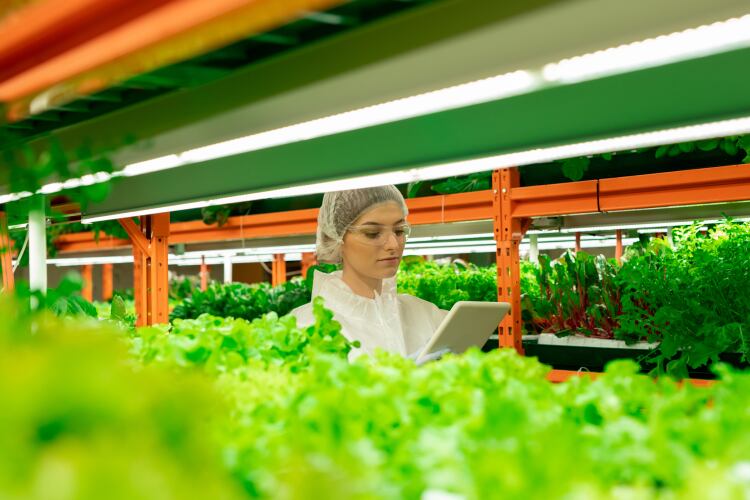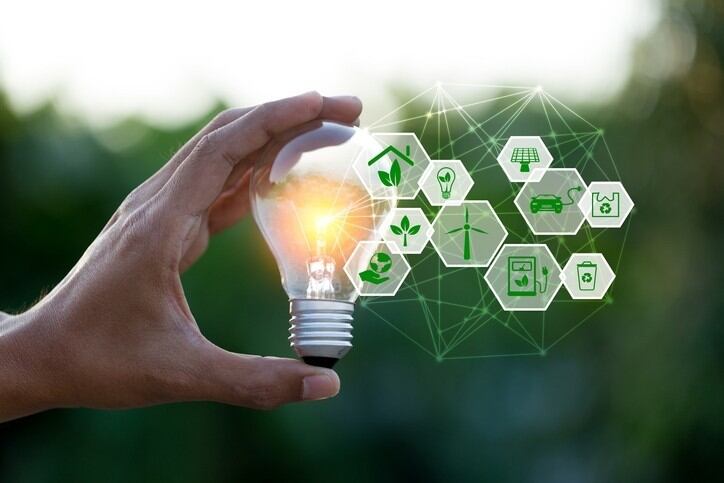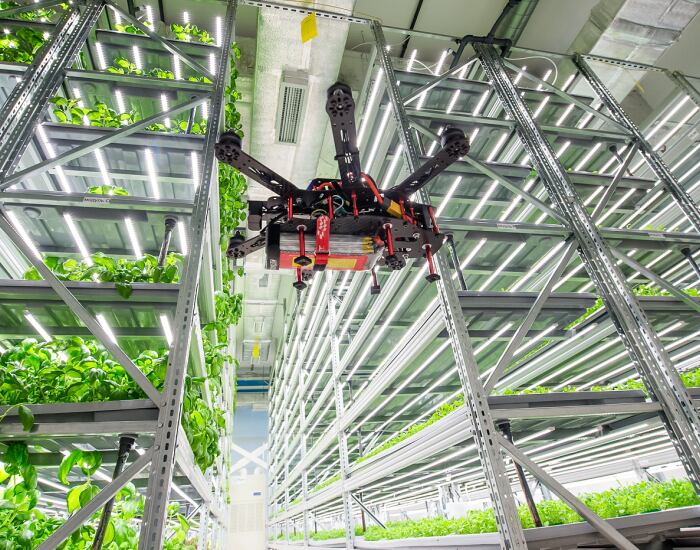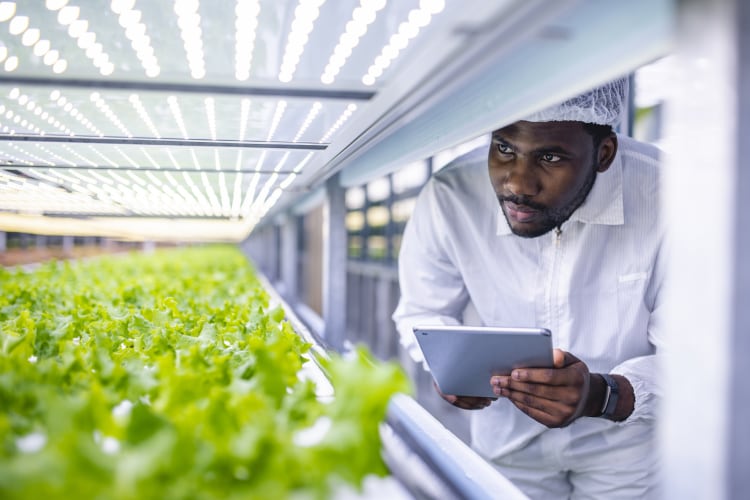Technological advancements in Controlled Environmental Agriculture (CEA) have raised hopes that the sector will be able to produce crops at scale with a lower environmental impact than conventional production.
“Vertical farms are poised to capitalize on a $50bn global market opportunity, in our view, as they can grow tastier produce at scale, without many of the conventional farming practices that contribute to climate change, and can ensure a fresh food supply at a local level,” analysts at Barclays Capital wrote in an investor note earlier this year.
Globally, the current agricultural system accounts for nearly a quarter of greenhouse gas emissions, uses nearly two-thirds of freshwater, and in many countries is also the biggest contributor to water pollution.
“Vertical farms circumvent many of these pressure points. That is, they do not need as much land and water; can operate 24 hours a day, 7 days a week, irrespective of volatile weather patterns; and can be located closer to the point of consumption, compressing the current supply chain. With the technology proven and a value proposition that is appealing to developed and developing economies alike, we believe vertical farms are in pole position to disrupt the global agricultural industry,” Barclays noted.
Benefits of CEA include increased water and land-use efficiency, reduced use of pesticides, reduced transportation requirements (because production can be brought closer to urban centres), year-round production and protection from environmental shocks like adverse weather events. CEA can also increase food safety because it insulates production from sources of contamination in the environment.

Innovation and investment rising
This investment case is attracting attention, with investment and innovation gathering pace. According to S2G Ventures, global investment in CEA was US$2bn in 2020, supporting advances in technology and rollout. Data from intellectual property firm Appleyard Lees shows patent numbers suggest continuing global investment, with the US and Europe leading the field, followed by China. Common patent filings address innovation in soilless cultivation, such as LED lighting, environmental control and sensors or data collection, Appleyard Lees’ inaugural Inside Green Innovation: Progress Report 2021 revealed.
“Patent numbers in soilless agriculture are growing, despite the technology’s relative maturity. Meanwhile, vertical farming is attracting early innovators trying to solve issues including nutrient control and lighting while reducing energy use and costs,” Chris Mason, Senior Associate at Appleyard Lees, explained.
Mason believes that looking at the hard data – patent filings – allows us to ‘by-pass the environmental rhetoric’ and ‘highlight the true state of progress in developing new, sustainable technologies’.
But sustainability is ‘not a given’
Sustainability is certainly a fundamental driver of investment and innovation in CEA. However, Barclays noted, sustainability in the sector ‘is not a given’.
“Industry players have to thread the needle, so to speak, as they invest in technology, showcase the ability to grow more than leafy greens at scale, establish a customer network, and build consumer demand – all while demonstrating a path to profitability and unlocking a menu of financing options,” Barclays said, outlining the scale of the challenge ahead.
Energy use is a particular sticking point. A common critique of CEA is that replacing natural sunlight and open air with LED bulbs and climate control uses significant amounts of electricity. As electricity sources become more renewable and as LED technology improves, energy-intense vertical farming will become both more sustainable – less carbon-intense – and more affordable. But this is dependent on the green energy transition or private investment in renewables.
“Given the heavy energy load required to power the controlled environment, we believe the industry needs to demonstrate that renewable energy sources can be used at scale (in addition to improving yield per kWh), which, while difficult and costly, could well render them carbon negative,” Barclays analysts noted.

CEA susceptible to ‘excessive greenwashing’?
The industry itself is not blind to these sustainability challenges – and the possibility that green claims that aren’t adequately documented could undermine credibility.
A new CEA Census Report from Agritecture and WayBeyond reveals a degree of anxiety among the sector over sustainability metrics and greenwashing. Discussing the outcome, WayBeyond CEO and Founder Darryn Keiller said the results ‘surprised us all’ with 70% of respondents suggesting the CEA industry is susceptible to ‘excessive greenwashing’.
“The fact that most growers believe misleading sustainability information is being shared is of concern and I’d say not entirely without merit although this is not just a CEA issue but agriculture as a whole. Further research would be required to confirm the accuracy of their beliefs,” he explained.
The sector would benefit from a ‘deeper analysis’ of its natural resource use and overall sustainability outcomes, Agritecture Founder and CEO Henry Gordon-Smith believes. Current levels of transparency represent a risk for the whole industry, he suggested.
“In my ten years in this sector, the evolution has been phenomenal, but the transparency and discussion around sustainability hasn’t advanced further than the usual commentary. As industry consultants, we’ve observed many instances of land and water savings, beneficial labour conditions, and increased product freshness - among other positive outcomes - when you compare CEA production with traditional field-grown produce. But we’ve also seen instances of individual operations relying on external case studies to make sweeping sustainability claims, rather than measuring their own data,” Gordon-Smith noted.
He insisted that there is ‘room for improvement’ when it comes to measuring sustainability metrics. “We need to see more accountability. If you’re doing great things - prove it. Tell your story with facts and data to back it up. Transparency is exactly what consumers want when it comes to the food they buy, and we want to be telling those positive, evidence-based stories that exist out there. Simply applying general industry claims to any one individual operation is likely what’s leading so many in the sector to feel that there is excessive greenwashing.”
Side-stepping the greenwashing trap
Finnish ag tech company iFarm is one CEA innovator that agrees transparency is vital for the industry’s future development.
"Vertical farming has many environmental benefits, but accuracy and transparency are essential. At iFarm, we’re committed to providing farmers, customers and the public with verifiable data and we’re eager for others to do the same,” commented Timo Koljonen, iFarm's EU Sales Director.
The company has developed its own software, iFarm Growtune, that enables it to continuously manage every process on-farm. Built into the system are data analytics for ‘all the necessary metrics’, Koljonen told us.
“Whether it’s how much water can be saved with indoor CEA or how much energy is required to grow two tonnes of strawberries, it’s easy to make vague claims about the environmental impact of new technology but independent testing should always be encouraged. That’s what our R&D department does: conducting rigorous experiments in our R&D labs, sharing data and results publicly and collaborating with reputable industry partners.”
For instance, Koljonen elaborated, vertical farming has been shown to use 95% less water than traditional farming. iFarm’s engineers have allowed the group to improve on this indicator, developing a dehumidification system that reuses water that the plants evaporate during growth. “When using our system, the amount of tap water required by a vertical farm to produce delicious and rich yields will be just 440 litres, which is five times less than what a hydroponic greenhouse needs.”

How can the CEA industry as a whole avoid the greenwashing trap?
“Objective verifications will ensure that CEA companies are held to account when they make unfounded environmental claims and prevent potential greenwashing throughout the sector,” Koljonen predicted.
He also sees scope for external certification or regulation. “Introducing new regulations or vertical farm certifications could help to elevate standards within the industry. In the same way that organic food producers must meet specific regulations, industry-wide guidelines could safeguard vertical farms and enhance the quality of produce. While some vertical farm companies shy away from scrutiny, iFarm welcomes it."




